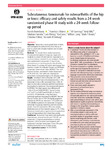Mostrar o rexistro simple do ítem
Subcutaneous tanezumab for osteoarthritis of the hip or knee: efficacy and safety results from a 24-week randomised phase III study with a 24-week follow-up period
| dc.contributor.author | Berenbaum, Francis | |
| dc.contributor.author | Blanco García, Francisco J | |
| dc.contributor.author | Guermazi, Ali | |
| dc.contributor.author | Miki, Kenji | |
| dc.contributor.author | Yamabe, Takaharu | |
| dc.contributor.author | Viktrup, Lars | |
| dc.contributor.author | Junor, Rod | |
| dc.contributor.author | Carey, William | |
| dc.contributor.author | Brown, Mark T. | |
| dc.contributor.author | West, Christine R. | |
| dc.contributor.author | Verburg, Kenneth M. | |
| dc.date.accessioned | 2020-08-10T09:25:06Z | |
| dc.date.available | 2020-08-10T09:25:06Z | |
| dc.date.issued | 2020-03-31 | |
| dc.identifier.citation | Berenbaum F, Blanco FJ, Guermazi A, Miki K, Yamabe T, Viktrup L, et al. Subcutaneous tanezumab for osteoarthritis of the hip or knee: efficacy and safety results from a 24-week randomised phase III study with a 24-week follow-up period. Ann Rheum Dis. 2020;79(6):800-810 | es_ES |
| dc.identifier.issn | 0003-4967 | |
| dc.identifier.uri | http://hdl.handle.net/2183/26121 | |
| dc.description | Trial registration number NCT02709486 | es_ES |
| dc.description.abstract | [Abstract] Objective. Tanezumab, a nerve growth factor inhibitor, was investigated for osteoarthritis (OA) of the hip or knee in a study with 24-week treatment and 24-week safety follow-up. Methods. This double-blind, randomised, phase III study enrolled adults in Europe and Japan with moderate-to-severe OA who had not responded to or could not tolerate standard-of-care analgesics. Patients were randomised to tanezumab 2.5 mg or 5 mg subcutaneously or matching placebo every 8 weeks (three doses). Co-primary end points were change from baseline to week 24 in Western Ontario and McMaster Universities Osteoarthritis Index (WOMAC) Pain and Physical Function, and Patient’s Global Assessment of OA (PGA-OA). Joint safety and neurological assessments continued throughout the 48-week study. Results. From March 2016 to December 2017, 849 patients were randomised and evaluated (placebo n=282, tanezumab 2.5 mg n=283, tanezumab 5 mg n=284). At week 24, there was a statistically significant improvement from baseline for tanezumab 5 mg compared with placebo for WOMAC Pain (least squares mean difference±SE –0.62±0.18, p=0.0006), WOMAC Physical Function (–0.71±0.17, p<0.0001) and PGA-OA (–0.19±0.07, p=0.0051). For tanezumab 2.5 mg, there was a statistically significant improvement in WOMAC Pain and Physical Function, but not PGA-OA. Rapidly progressive osteoarthritis (RPOA) was observed in 1.4% (4/283) and 2.8% (8/284) of patients in the tanezumab 2.5 mg and tanezumab 5 mg groups, respectively and none receiving placebo. Total joint replacements (TJRs) were similarly distributed across all three treatment groups (6.7%–7.8%). Tanezumab-treated patients experienced more paraesthesia (5 mg) and hypoaesthesia (both doses) than placebo. Conclusion. Tanezumab 5 mg statistically significantly improved pain, physical function and PGA-OA, but tanezumab 2.5 mg only achieved two co-primary end points. RPOA occurred more frequently with tanezumab 5 mg than tanezumab 2.5 mg. TJRs were similarly distributed across all three groups. | es_ES |
| dc.language.iso | eng | es_ES |
| dc.publisher | BMJ | es_ES |
| dc.relation.uri | http://dx.doi.org/10.1136/annrheumdis-2019-216296 | es_ES |
| dc.rights | Atribución-NoComercial-SinDerivadas 4.0 España | es_ES |
| dc.rights.uri | http://creativecommons.org/licenses/by-nc-nd/4.0/es/ | * |
| dc.subject | Osteoarthritis | es_ES |
| dc.subject | Knee osteoarthritis | es_ES |
| dc.subject | Analgesics | es_ES |
| dc.title | Subcutaneous tanezumab for osteoarthritis of the hip or knee: efficacy and safety results from a 24-week randomised phase III study with a 24-week follow-up period | es_ES |
| dc.type | info:eu-repo/semantics/article | es_ES |
| dc.rights.access | info:eu-repo/semantics/openAccess | es_ES |
| UDC.journalTitle | Annals of the Rheumatic Diseases | es_ES |
| UDC.volume | 79 | es_ES |
| UDC.issue | 6 | es_ES |
| UDC.startPage | 800 | es_ES |
| UDC.endPage | 810 | es_ES |
Ficheiros no ítem
Este ítem aparece na(s) seguinte(s) colección(s)
-
INIBIC- REUMA - Artigos [184]







